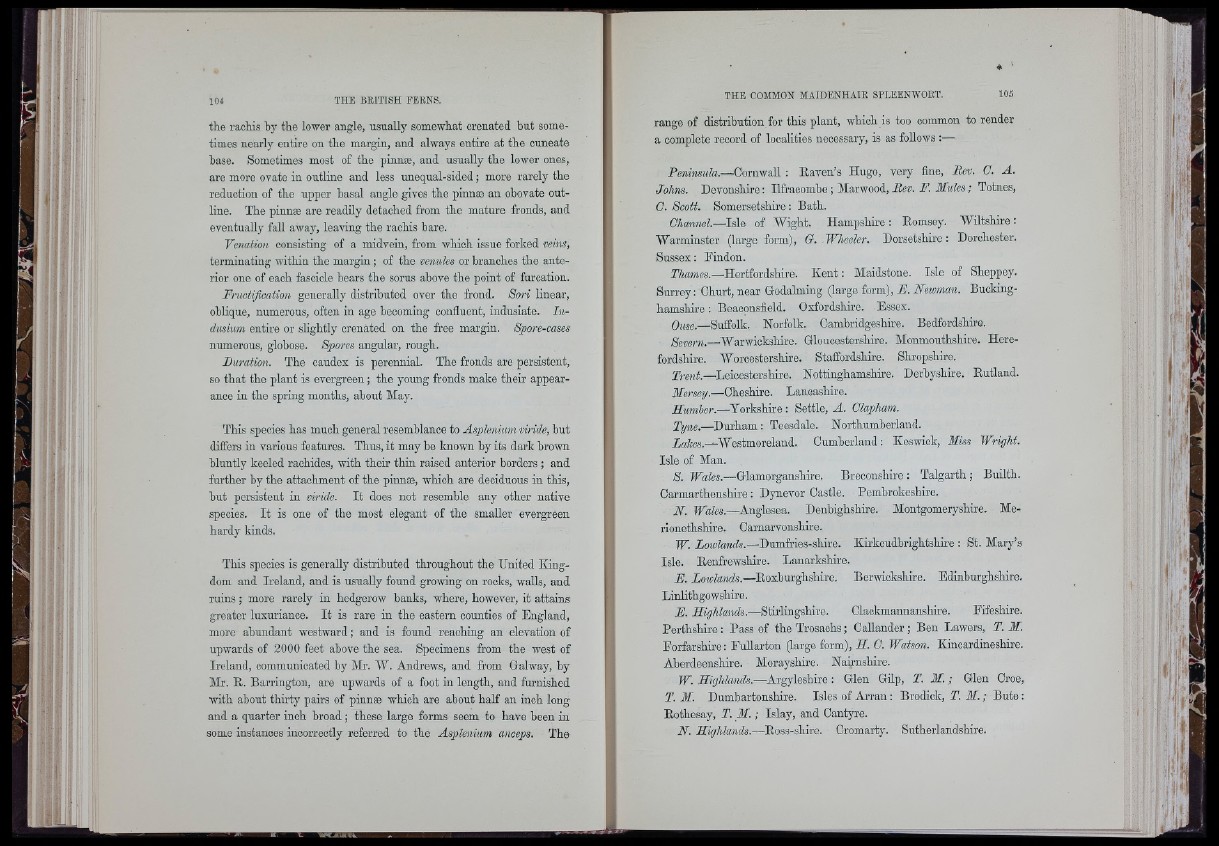
I
.1
i
Ji !lii
H'
the rachis by the lower angle, usually somewhat crenated but sometimes
nearly entire on the margin, and always entire at the cuneate
base. Sometimes most of the pinnæ, and usually the lower ones,
are more ovate in outline and less unequal-sided ; more rarely the
reduction of the upper basal angle gives the pinnæ an obovate outline.
The pinnæ are readily detached from the mature fronds, and
eventually fall away, leaving the rachis bare.
Venation consisting of a midvein, from which issue forked veins,
terminating within the margin ; of the vemdes or branches the anterior
one of each fascicle bears the sorus above the point of furcation.
Fructification generally distributed over the frond. Sori linear,
oblique, numerous, often in age beooming confluent, indusiate. In-
clusium entire or slightly crenated on the free margin. Spore-cases
numerous, globose. Spores angular, rough.
Buration. The caudex is perennial. The fronds are persistent,
so that the plant is evergreen ; the young fronds make their appearance
in the spring months, about May.
This species has much general resemblance to Asplenium viride, but
differs in various features. Thus, it may be known by its dark brown
bluntly keeled rachides, with their thin raised anterior borders ; and
further by the attachment of the pinnæ, which are deciduous in this,
but persistent in viride. It does not resemble any other native
species. It is one of the most elegant of the smaller evergreen
hardy kinds.
This species is generaUy distributed throughout the United Kingdom
and Ireland, and is nsuaUy found growing on rocks, waUs, and
ruins ; more rarely in hedgerow banks, where, however, it attains
greater luxuriance. It is rare in the eastern counties of England,
more abundant westward ; and is found reaching an elevation of
upwards of 2000 feet above the sea. Specimens from the west of
Ireland, communicated by Mr. W. Andrews, and from Galway, by
Mr. El. Barrington, are upwards of a foot in length, and furnished
with about thirty pairs of pinnæ which are about half an inch long
and a quarter inch broad ; these large forms seem to have been in
some instances incorrectly referred to tho Asplemum anceps. The
range of distribution for this plant, which is too common to render
a complete record of localities necessary, is as foUows :—■
Peninsula.—CornwaU : Eaven’s Hugo, very fine. Rev. C. A.
Johns. Devonshire: Ilfraoomhe; Marwood,-Be», id ; Totnes,
G. Scott. Somersetshire: Bath.
Channel.—Isle of Wight. Hampshire; Eomsey. Wiltshire:
Warminster (largo form), G. Wheeler. Dorsetshire: Dorchester.
Sussex: Findon.
Thames.—Hertfordshire. K ent: Maidstone. Isle of Sheppey.
Surrey; Chnrt, near Godalming (large form), F. Neioman. Buckinghamshire
; Boaoonsfield. Oxfordshire. Essex.
Ouse.—Suffolk. Norfolk. Cambridgeshire. Bedfordshire.
Severn.—^Warwickshire. Gloucestershire. Monmouthshire. Herefordshire.
Worcestershire. Staffordshire. Shropshire.
Trent.—Leicestershire. Nottinghamshire. Derbyshire. Rutland.
Mersey.—Cheshire. Lancashire.
Humber.—Yorkshire: Settle, A . Clapham.
Tyne.—Durham: Teesdale. Northumberland,
iaites.—Westmoreland. Cumberland; Keswick, Miss Wright.
Isle of Man.
S. Wales.—Glamorganshire. Breconshire : Talgarth ; Builth.
Carmarthenshire; Dynevor Castle. Pembrokeshire.
N. Wales.—Anglesea. Denbighshire. Montgomeryshire. Merionethshire.
Carnarvonshii-e.
W. Lowlands.—Dumfries-shire. Kirkcudbrightshire : St. Mary’s
Isle. Renfrewshire. Lanarkshire.
F. Roxburghshire. Berwickshire. Edinburghshire.
Linlithgowshire.
E. Highlands.—Stirlingshire. Clackmannanshire. Fifeshire.
Perthshire : Pass of the Trosachs; Callander ; Ben Lawers, T. M.
Forfarshire: Fullarton (large form), H. C. Watson. Kincardineshire.
Aberdeenshire. Morayshire. Nairnshire.
W. Highlands.—Argyleshire : Glen Gilp, T. M .; Glen Croe,
T. M. Dumbartonshire. Isles of Arran: Brodick, T. M .; Bute;
Rothesay, T. i i i.; Islay, and Cantyre.
N. Highlands.—Ross-shire. Cromarty. Sutherlandshire.
i‘1
■ , ( .1
■■ ; i I
.• i M
•! » • ' '
‘.Ii;'
"I
m
iii*